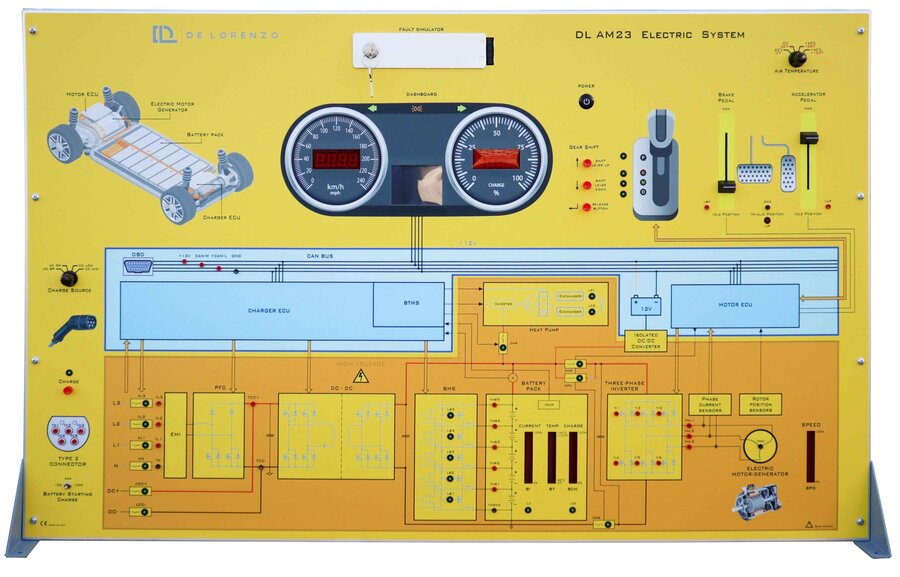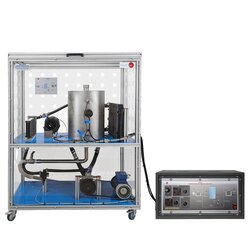Electric Vehicle System (DL AM23)


PL-309625
The DL AM23 Simulator allows the theoretical and practical study of the main systems and components found in Electric Vehicles (EV). It consists of a panel that shows the complete diagram of all the components, with switches, buttons, commutators and potentiometers to reproduce the different operating situations that can be set by the students according to the courseware. There are also displays, LED bars, LEDs, measurement terminals to show the operating status of the system and detect the available electrical quantities. The various sections of the diagram are represented with different colours to highlight both the different components of the electric vehicle and the high and low voltage areas that concern the specific safety issues of this type of vehicle. There is an OBD-II socket to which a Scantool can be connected to perform testing operations in the same way as in real vehicles. The system is completed by a Fault Insertion Unit with switch, with protection key for access by the Teacher only. The connection of the Simulator to the PC for supervision, graphic display of the parameters of interest such as speed, temperatures, etc., is obtained via a special USB interface. The Simulator is accompanied by the Windows application DLworkspace which provides an integrated teaching environment for using the Simulator itself.
This previous application brings together, in a single graphical user interface, all the tools required to use the Simulator:
- the Training Software (i.e. the teaching material) with the theoretical guide to the study topics, the guide to the exercises, the questionnaires and the guide to troubleshooting;
- the tools for the display of the quantities acquired by the Simulator with high graphic performance;
- some service tools such as Dashboard and Scantool.
It has the following technical characteristics:
- 7-segment display to show the vehicle's forward speed and battery charge level,
- Pushbutton ignition key,
- Potentiometers and buttons to select the operational conditions,
- LED bars for:
- battery temperature,
- charging and delivered currents,
- motor rotation speed.
- LED displaying the status of the devices,
- Test jacks/Terminals for measuring and testing,
- Battery voltage test points (*),
- Battery charge test points Vac/Vdc (*),
- Motor control test points – PMSM (Permanent Magnet Synchronous Motor) (*),
- Fault entry system with switches and key cover,
- OBD-II Connector,
- USB interface with dynamic display of the parameters on the PC screen,
- Power supply: 220 Vac ± 10%, 50 Hz. (*): All test points report 'real' DC or AC voltage signals, appropriately scaled in value.
The educational program includes the following topics:
- Architecture of an electric vehicle.
- Technical issues and solutions.
- The battery:
- Battery types,
- Charging batteries,
- Battery Management System - BMS,
- Battery Thermal Management System - BTMS.
- The electric motor:
- Permanent Magnet Synchronous Motor – PMSM or SMPM,
- Driving with Inverter,
- Data network,
- The motor control unit - ECU.
- Vehicle Operation:
- Motor starting,
- Low and high speed operation,
- Acceleration, deceleration, braking and reverse,
- Regenerative braking,
- CAN Network and OBD Diagnosis,
- Electrical safety.
You may notice:
- the list of topics and lessons on the left,
- the lesson pages in the centre,
- the supervision tools, videos, and management of answers to questions on the right.
Faults Entry by the Teacher
- Via the 16 switches of the Fault Insertion Unit, with access key.
- Via the DLworkspace Fault Entry window, protected by a password.
Faults Entry by the Student
- The Student inserts faults, guided by the Training Software lessons, via the Faults View window of the DLworkspace.
- For each fault, there are questions related to it to verify the correctness of the search.
OBD connector and Scantool
The DL AM23 Simulator is equipped with an OBD connector on the left side that allows connection to a Scantool for diagnostic operations on the vehicle. The control units inside the Simulator are equipped with a CAN-BUS interface and OBD-II protocol. They provide the same diagnostic information as real control units to an external Scantool. A real Scantool is supplied which can be used for diagnosis on any car, compliant with standards ISO 15031 e SAE J1979. In case of USB connection to the computer, DLworkspace provides an additional Scantool software and the car Dashboard.What is this?
These percentage scores are an average of 0 user reviews. To get more into detail, see each review and comments as per below
If you have used this product, support the community by submitting your review



